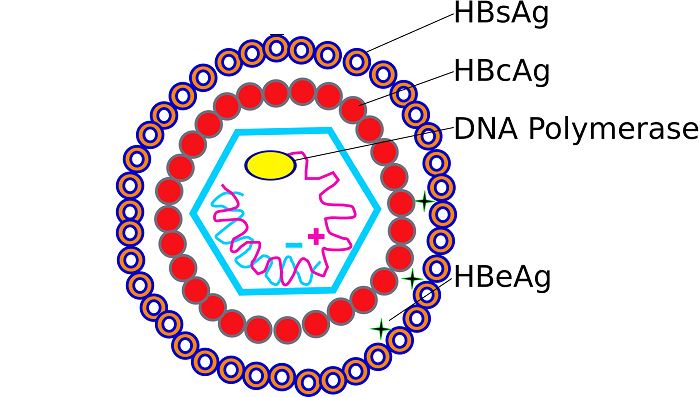HBV
 The hepatitis B virus (HBV) is a small DNA virus with unusual features similar to retroviruses. HBV is classified into eight genotypes, A to H. Each genotype has a distinct geographic distribution. Three types of viral particles are visualized in infectious serum by electron microscopy. Two of the viral particles are smaller spherical structures with a diameter of 20 nm and filaments of variable lengths with a width of 22 nm. The spheres and filaments are composed of hepatitis B surface antigen (HBsAg) and host-derived lipids without viral nucleic acids and are therefore noninfectious. The infectious HBV virion has a spherical, double-shelled structure 42 nm in diameter. It consists of a lipid envelope containing HBsAg that surrounds an inner nucleocapsid composed of hepatitis B core antigen (HBcAg) complexed with a virally encoded polymerase and the viral DNA genome. The genome of HBV is a partially double-stranded circular DNA of about 3.2 kb pairs. The viral polymerase is covalently attached to the 5′ end of the minus strand.
The hepatitis B virus (HBV) is a small DNA virus with unusual features similar to retroviruses. HBV is classified into eight genotypes, A to H. Each genotype has a distinct geographic distribution. Three types of viral particles are visualized in infectious serum by electron microscopy. Two of the viral particles are smaller spherical structures with a diameter of 20 nm and filaments of variable lengths with a width of 22 nm. The spheres and filaments are composed of hepatitis B surface antigen (HBsAg) and host-derived lipids without viral nucleic acids and are therefore noninfectious. The infectious HBV virion has a spherical, double-shelled structure 42 nm in diameter. It consists of a lipid envelope containing HBsAg that surrounds an inner nucleocapsid composed of hepatitis B core antigen (HBcAg) complexed with a virally encoded polymerase and the viral DNA genome. The genome of HBV is a partially double-stranded circular DNA of about 3.2 kb pairs. The viral polymerase is covalently attached to the 5′ end of the minus strand.
HBV infection leads to a wide spectrum of liver disease ranging from acute hepatitis to chronic hepatitis, cirrhosis, and hepatocellular carcinoma (HCC). Approximately one-third of adults with acute HBV infection develop clinical symptoms and signs of hepatitis.
If you can’t find your product on this list? Please directly send email to
For Research Use Only. NOT FOR CLINICAL USE.
Online Inquiry
Welcome! For price inquiries, please feel free to contact us through the form on the left side. We will get back to you as soon as possible.
